I’ll just come out and say it. Florence is one of the most beautiful cities in the world.
I mean, it was the centre of the Italian Renaissance where Michelangelo, Leonardo da Vinci, Botticelli, and renowned artists of their era mastered their trade. Many masterpieces are still held in Florentine art galleries today, drawing millions of culture-loving tourists each year.
But art isn’t the only beautiful thing about Florence. Streets are lined with exquisite medieval architecture, from 12th century palaces to the awe-inspiring Florence Duomo. Home-style Italian cooking is found around every corner. Artisans and leathermakers craft world-class products. And of course, Florence is the capital of Italy’s Tuscany region, famous for its rolling hills, peaceful countryside, and award-winning wine.
Yep, there’s a lot to love about Florence.
I’ve been fascinated with the history of Florence since watching the Netflix series Medici: Masters of Florence, which tells of the wealthy banking family’s rise to power amidst clan rivalry, passion, and betrayal. The Medici’s influence on Florence’s prosperity is still clearly visible today, spanning galleries, street names and even their family crest embedded into almost every public building.
Millions of tourists have fallen in love with the indefinable charm and inspiring energy of Florence, and so did I. Now you can too with my 4-day Florence itinerary - all the best bits, without the drama… unless you really want it.
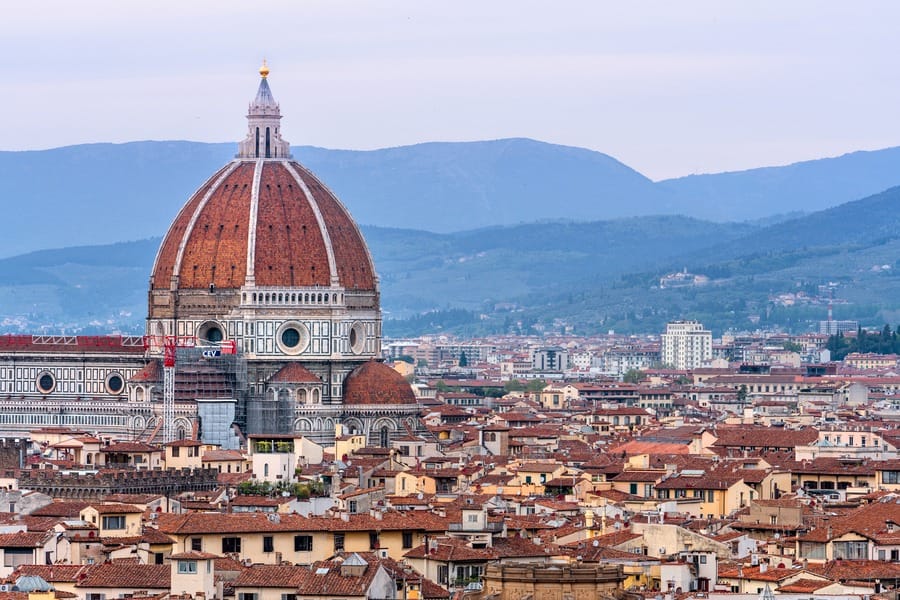
Florence tip: Before visiting Florence, watch the Netflix series Medici: Masters of Florence for a quick download on a pivotal period in Florentine history.
Italy tip: Florence has its own airport, but it's pretty small and flights are often expensive. Check flight prices to Pisa first. These Pisa airport transfers to Florence are pretty affordable and give you a chance to see the gorgeous Tuscan countryside at the same time.
Day 1
9am – Michelangelo’s David and the Florence Duomo on the Best of Florence Tour
The beauty of Florentine art and architecture is best experienced with a knowledgeable guide who reveals the juicy stories behind each piece.
We booked Take Walks’ Best of Florence Walking Tour and met our group at Piazza San Marco before walking to the Galleria dell'Accademia (Academy Gallery), home to Michelangelo’s legendary David sculpture.
By 9:15am, a huge queue was already winding around the building, so we were relieved when our guide, Matt, pulled out fast track tickets and ushered our group to the front.
According to Matt, the Academy has the largest collection of Michelangelo sculptures in the world, many of which were never finished and shed otherwise impossible insight into the master artist’s unique sculpting process.
Matt gave us a quick tour around the gallery, pointing out various paintings that demonstrated the creative transition from Gothic into the Renaissance. As marvellous as these pieces are, David couldn’t help but steal the show.

Nothing can prepare you for the shear intensity radiated by the colossal statue. And by colossal, I mean absolutely huge, standing at a whopping 5.17 metres (17 feet)! According to Matt, the original block of marble was abandoned for 25 years as its gigantic size and structural flaws deterred potential artists from attempting to sculpt it… until a 26-year-old Michelangelo came along, of course.
I was amazed that a lifeless statue like David can emanate such strong emotions of sheer determination and strength. Matt said in order to achieve this level of feeling and movement, Michelangelo spent 10 days and 10 nights in a morgue studying human anatomy (it was illegal at the time). How’s that for dedication to the job?
Next we walked to the Florence Duomo, a complex of three marble buildings that served as the centre of Florentine faith: the Baptistery of St John, Giotto’s Bell Tower, and the Cathedral of Santa Maria del Fiore. The three buildings are made of Tuscan marble in white, green, and red, which Matt said represent faith, hope and charity.

Other attractions visited on this tour included the Church of Orsanmichele, street artists skilfully crafting chalk portraits on pavement, a collection of Renaissance sculptures in Piazza della Signoria, and the unmistakable Ponte Vecchio bridge.

12pm – Lunch
After the tour, we crossed the Ponte Vecchio to the south side of the Arno River which, according to Matt, is where all the locals go to eat.
We found a simple restaurant, Pane e Olio, where we enjoyed the sunshine in Piazza Santa Felicita along with authentic Italian pizza.
1pm – Visit Michelangelo’s tomb at the Church of Santa Croce
We walked through Piazza di Santa Croce a couple of times and was amazed by the grandiose church standing at the east end. There was something about the marble-clad basilica that whispered “I have a story to share”.
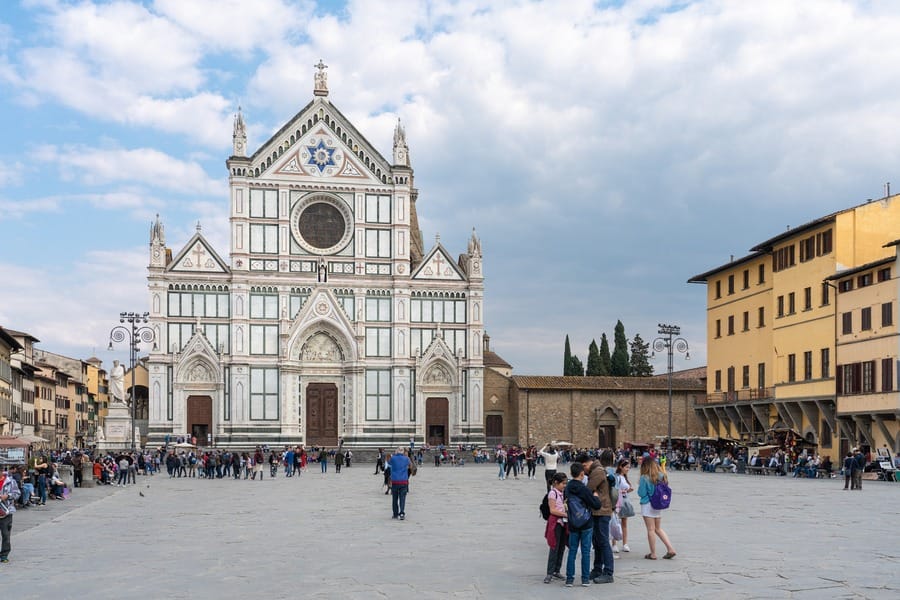
Inside the church we discovered a series of tombs and monuments, including those of Michelangelo and Niccolo Machiavelli. Be careful where you walk because you never know what, or who, you might be standing on. Skeletons and all, the Basilica of Santa Croce is fascinating and should not be missed.
Book Santa Croce tickets online with Viator
Entry: €8 per adult, €6 per child (11-17 years, or free when accompanied with a parent), free for children under 11.
Hours: 9:30am – 5:30pm (last admission at 5pm), Monday to Saturday
Tip: the visitor entrance is located on the north side of the church, and it’s normally not too busy so buying tickets in advance isn’t required.
2pm – Try the Best Gelato in Italy
A highlight in Florence was finding my new favourite gelataria in Italy, or maybe even in the world. You might think I’m prone to sensationalised statements. But not here.
Upon first glance, the unassuming Gelataria Edoardo had all the trademarks of respectable gelato: covered stainless steel containers, 100% organic natural ingredients, and no artificial colours. But the smooth, springy texture and pure velvety flavours sealed the deal. However, what set them over the top was the vegan options and gluten-free cones. Now everyone can enjoy a taste of heaven.
Edoardo has my highly-coveted “thumbs up of approval”.
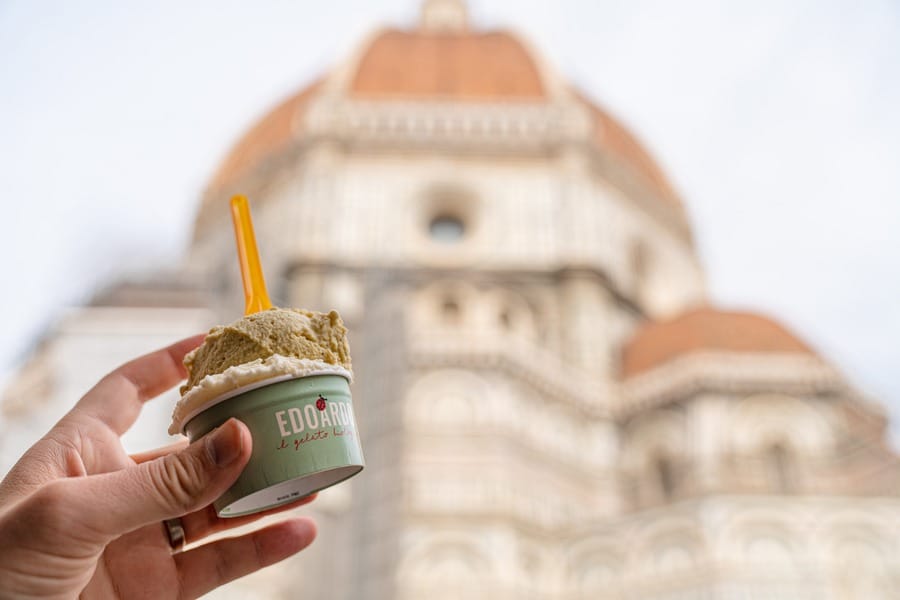
2:30pm – Buy Italian Leather Merch at the San Lorenzo Market
Almost every street in Florence is lined with leather bags and jackets bursting out of storefronts, but the Mecca of Italian leather is Mercato di San Lorenzo. This outdoor market sprawls as far as the eye can see with a huge range of leather jackets, bags, wallets, belts, journals, keyrings, and pretty much anything else that can possibly be made of leather (you’ll be surprised!). Vendors expect customers to barter and after little haggling, you can pick up a new leather jacket or handbag for a pretty reasonable price.
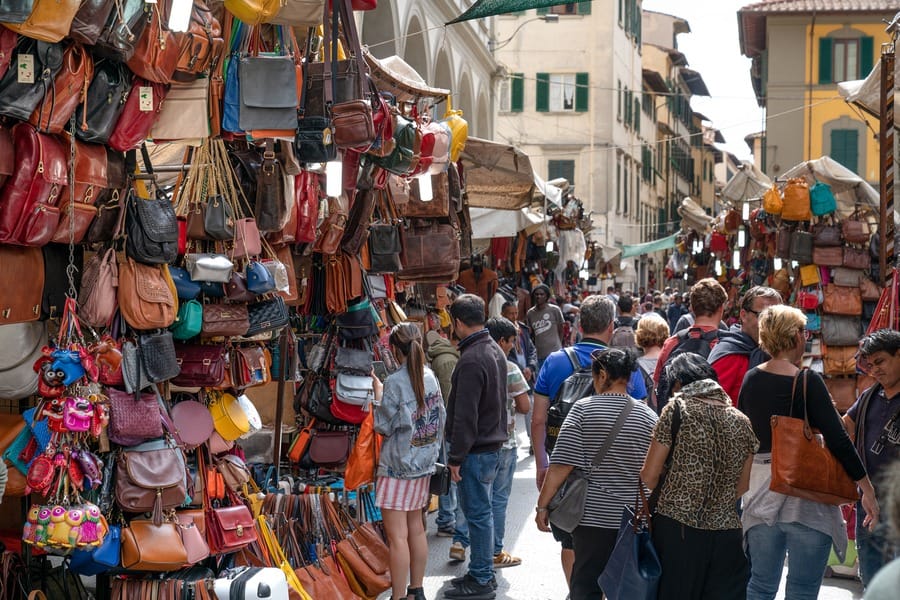
While you’re in the area, head to the indoor section of the market, known as Mercato Centrale Firenze, which is all about food, food and more food. The top floor is full of fresh produce from deli meats and cheeses, to pastries, to fruits and vegetables, while the bottom level hosts a gourmet food court.
There are actually two leather markets in Florence, the other is Mercato del Porcellino which is smaller, with similar items and less variety. However, it does have a “lucky boar fountain”.
Florence tip: We were warned that some vendors sell “pleather” rather than genuine Italian leather. Before buying, check the labels for “100% genuine leather”, or something along those lines.
4:30pm Stop for an Aperitif
Give your feet a rest and stop for a drink at a nearby bar or café. I recommend Tavernetta del Battistero, just outside the Leonardo da Vinci Museum. Try a glass of Tuscan wine or the classic Italian aperitif, Aperol Spritz, made from Aperol, prosecco, and sparkling water.
5pm – Visit the Leonardo da Vinci Museum
In addition to being one of the best artists the world has ever known, Leonardo da Vinci was a genius engineer. His inventions were ground-breaking at the time, making huge leaps towards sustained human flight as well as weapons of war (those paid the bills).
The Leonardo da Vinci Museum in Florence is dedicated to his engineering breakthroughs and inventions, featuring copies of his designs, notes, and drawings. There’re also recreations of his flying machines, war machines, civil infrastructure, and other inventions like a robot (yes!). Many exhibits are interactive and provide fascinating insight into the meticulous mind of Leonardo da Vinci.
The only drawback – you’re not allowed to take photos inside. Shhhh, don’t tell anyone about mine!
Entry: €7 per adult, €5 per child (7-18 yrs)
Hours: 10am - 7pm, daily
6:30pm – Dinner
Florence is home to dozens of gourmet Italian restaurants, but I’d rather dine at an authentic osteria or trattoria, smaller restaurants that typically sell local wine and food that’s humble yet delicious. These are usually located down side streets and away from the main tourist-clad squares.
We ate at Trattoria Nella, where were lucky to get a table. About 15 minutes after we arrived, every seat was full, and for good reason. The fresh pasta and risotto was absolutely to die for. I recommend reserving a table ahead of time through Google Maps.
Florence food tip: If you’d like to try a local Tuscan wine ask your waiter for a recommendation. Every Florentine waiter we encountered gave fantastic wine recommendations.
Day 2
8:30am – Climb the Leaning Tower of Pisa and Visit Medieval Town, Lucca.
No trip to Italy is complete without a stop at the Leaning Tower of Pisa, and since Florence provides the perfect base for a day trip, we booked Take Walks’ Florence to Pisa Day Trip with Winery Lunch and Lucca Tour.
We met our tour group at Piazza Della Repubblica, piled into a mini-van, and started the 90-minute drive to Pisa. Along the way, our guide, Laura, pointed out landmarks and vineyards, and shared a brief history on Pisa. It turns out that Pisa is way more historical than most people know. It was an important trade town during ancient Roman and medieval periods due to its close proximity to the sea and river network.
Like most Italian cities, Pisa is built around its religious centre of 3 buildings: a baptistery, a cathedral, and a bell tower. It’s the bell tower that’s famously dubbed “The Leaning Tower of Pisa”, but as Laura pointed out, if you look closely, all three buildings are in fact leaning. Despite its angled state, the bell tower still serves its intended purpose with bells chiming at 12pm each day. Unlike most bell towers, the chime is aided by an electronic device to avoid movement and vibration-related damage to the tower.

Laura gave us free time to walk around the complex and take the classic “holding up the tower” photo before our scheduled climb. If you’ve never climbed the Leaning Tower of Pisa, it’s something that simply must be added to your bucket list. I didn’t expect to enjoy the climb as much as did. Thanks to the tower’s slant, and the engineers’ attempt to overcompensate for the angle part-way through construction, it felt like a cross between an illusion house and having drunk too much Tuscan wine.
Hang on, it’s only 10 in the morning!
There’s one particular point near the 4th floor where it feels like your walking on level ground instead of climbing up stairs. Totally trippy!
At the top of the tower, we admired the 360-degree panoramic views of Pisa and the famous bells.
Fun Pisa fact: Pisa was the hometown of renowned physicist and astronomer, Galileo, who conducted several gravity experiments by throwing objects, including a cannon ball, off the Leaning Tower of Pisa.
After making our way down the tower and recovering from the ensuing vertigo, we visited the Cathedral of Pisa, adorned with marble columns, magnificent Renaissance paintings, and on the day of our visit, dazzling sunbeams.
I don’t know what it is about Italian churches housing dead people, but it seems to be a common theme. This church is home to the tomb of Saint Rainerius, the patron saint of Pisa (and also travellers). In case you’re wondering if he’s really inside, the tomb has a glass panel making his skeleton very visible. Creepy.
After a little more free time to buy souvenirs, we left Pisa just as it was starting to get crowded, and drove off to lunch at Tuscan vineyard, Fattoria del Teso. Lunch started with a tasting of 5 wines (3 white and 2 red) paired with a tasting platter of cheeses, honey, smoked salmon, hummus, and deli meats, before the main course, spaghetti bolognaise.
Food tip: Inform your guide of any dietary requirements on the morning of your tour so they can call ahead and ask the vineyard to prepare a special meal for you.
Next, we drove 30 minutes to the medieval town of Lucca, which used to be a regular stop along the Pilgrims’ Way, but is now most famous for hosting annual music festivals with performances by the likes of Elton John and The Rolling Stones. I was amazed that such a small town attracts such big acts!
Laura provided a relaxing walking tour around Lucca, stopping along the city’s Roman walls, at some of the town’s 100+ churches, and to admire statues in public squares, like Piazza dell’Anfieatro, a former Roman amphitheatre.
We then enjoyed free time for shopping and enjoying a drink before the 70-minute drive back to Florence. Phew!
7:30pm: Dinner
Exhausted from our 10-hour tour, we found a nearby restaurant for a quick dinner before returning to our Airbnb apartment. I usually avoid restaurants in public squares as they tend to be overpriced with sub-par food, but Ristorante La Grotta Guelfa was recommend by Laura so I gave it a shot and was pleasantly surprised. Food was delicious, the service was friendly and the prices were relatively reasonable. Try the tortelli with wild boar – a Florentine specialty.
Day 3
Visit the Florence Duomo
If you did the Best of Florence Tour, your guide would have shared a brief history on the Florence Duomo and you may have quickly visited inside the cathedral. I suggest returning to the Duomo in your own time to climb the cathedral’s dome and the bell tower and to visit inside the Baptistery of St John, Crypt of Santa Reparata, and the Museum of Opera of Santa Maria del Fiore.
Tickets can be bought as a package online for €20 per person. At the time you book, you’ll have to select a non-changeable timeslot to climb the dome. I suggest booking these tickets in advance as they need to be printed and time slots to climb the dome sell out pretty fast. People without pre-booked timeslots were constantly being turned away on the day of our climb.
9am – Visit the Baptistery of St John
To enter the Baptistery of St John, you’ll simply need to scan your pre-purchased ticket and proceed through a security check. The baptistery is exquisitely decorated with bronze relief doors and a mosaic ceiling, both depicting scenes from the bible.
9:30am – Climb Brunelleschi’s Dome
The dome of Santa Maria del Fiore has a fascinating backstory. Due to its large diameter (45.5 metres / 149 feet) the dome couldn’t be constructed until 100 years after the rest of the cathedral was finished. Finally, Renaissance architect Filippo Brunelleschi came up with a new construction method involving 2 interconnecting shells made of brick in a herringbone pattern.
Today, visitors can climb in between the two shells to reach the top balcony which has the best views over central Florence.
Florence tip: I suggest watching Medici: Masters of Florence, which depicts some of the drama behind the construction of the dome.
On the day of our climb, we scanned our tickets and commenced the ascent up a series of narrow staircases. For the first few minutes, it seemed like the climb was going to be a piece of cake! We popped out at an internal balcony about half way up to admire the ceiling frescos up close, then continued to climb, up, and up, and up. The higher we got, the steeper and narrower the stairwell got. There were even a couple of sections where we had to share the tiny passageway with people climbing down. This is not an activity for the claustrophobic!
We reached the top and gratefully took in a deep breath of fresh, Florentine air while we soaking in the views from the circular balcony. It was quite strange to see a landscape of Florence without the iconic dome front and centre! Haha!
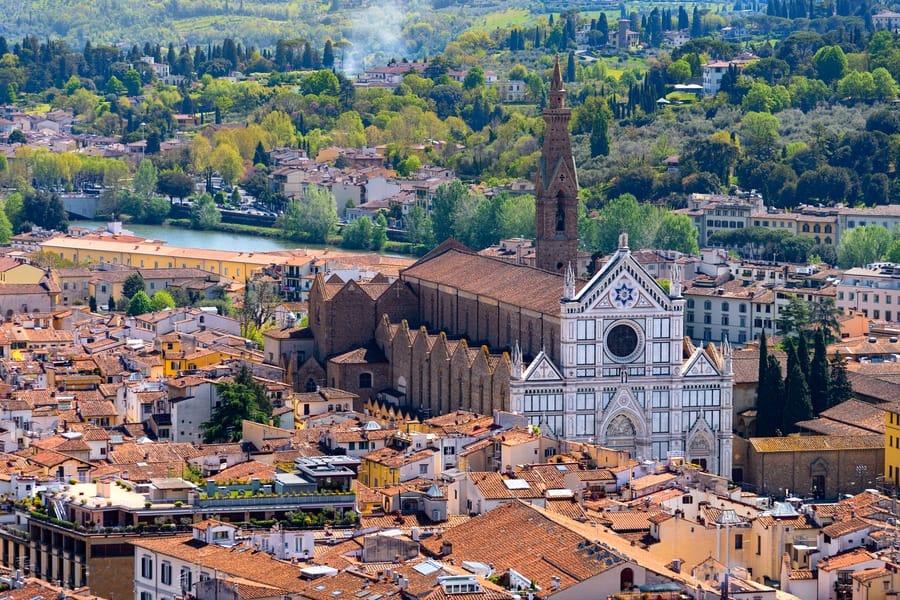
11am – Visit the Crypt of Santa Reparata
The Crypt of Santa Reparata is an archaeological excavation site located beneath the cathedral of Santa Maria del Fiore. It contains remarkably well-preserved ruins of an early Christian church as well as houses dating back to the Roman period and several gravestones.
12pm – Climb Giotto’s Bell Tower
If your legs can handle another climb, make your way over to Giotto’s Bell Tower, which is considered the most beautiful campanile (bell tower) in Italy. Advanced reservations aren’t required to climb the bell tower and the queues aren’t usually too long. I guess most tourists learn their lesson after climbing the dome. If you’re a glutton for punishment, simply scan the same ticket (used to climb the dome) and commence the upward journey.
I’ll just wait for you downstairs.
1pm – Lunch break
Give your legs a break from all that intense cardio, with a well-deserved high-carb lunch. I suggest Giannino in San Lorenzo, located just outside Piazza del Duomo. Try the ravioli.
Take that, Jillian Michaels!
2pm – Visit the Museum of Opera of Santa Maria del Fiore
Refreshed from lunch, walk over to the Museum of Opera of Santa Maria del Fiore, which holds a massive collection of precious items that once lived in the Cathedral of Santa Maria del Fiore, St John’s Baptistery, or Giotto’s Bell Tower.
The 3-story museum includes the original bronze door panels from baptistery, sculptures by Renaissance artists like Michelangelo and Donatello, precious religious artefacts, and intricately decorated priestly garments, to name just a few of the exhibits.
3:30pm – Undo Dome Climb Calorie Loss with my Favourite Gelato
Make another stop at Gelataria Edoardo while you’re in the area. After all, you’re on vacation in Italy! It would be a crime not to spoil yourself with gelato this delicious. Especially after all those stairs from the dome climb. At least that’s what I tell myself.
4pm – Medici Hall of Maps at Palazzo Vecchio
Palazzo Vecchio (literally translated as “old palace”), is most famous as the meeting place of the “Signoria” and “Priori”, the government that ruled the Republic of Florence during the middle ages and Renaissance. You’ll probably recognise it if you’ve watched Medici: Masters of Florence (hint, hint!).
Aside from being the current City Hall of Florence, Palazzo Vecchio contains a museum with exquisite Renaissance paintings, an archaeological site with ruins of a Roman theatre, and medieval fortress, Arnolfo’s Tower.
We only visited the museum and were blown away by the exquisite artwork inside. Highlights included the Hall of Five Hundred which features wall-size duelling paintings originally started by Michelangelo and Leonardo da Vinci but completed by Giorgio Vasari, and the Medici Hall of Maps, which features over 50 intricate hand-painted maps from the 16th century - utterly heavenly for a map geek like me
At the time of our visit, there was also an exhibit dedicated to Leonardo da Vinci which featured a time line of his life and several letters he’d written to prominent Florentine figures.
Book Palazzo Vecchio tickets online with Getyourguide
Entry: €10 for museum only, €14 for museum + Arnolfo’s Tower, or the museum + archaeological site, and €18 for all 3 attractions.
Hours: 9am - 7pm, daily
7 pm – Watch the Sunset from Pizzale Michelangelo
Our Best of Florence tour guide, Matt, suggested we visit Pizzale Michelangelo, apparently a “secret” lookout point that’s the best place to watch the sunset in Florence. When we arrived, we realised that either Matt played a little joke on us, or his definition of “secret” is seriously up the creek.
We arrived at Pizzale Michelangelo a little early and the riverside lookout point was already buzzing with dozens of locals, tourists, and even street vendors selling souvenirs.
If you don’t mind joining the crowds, I recommend brining a picnic snack or bottle of wine and sitting on the steps to watch the sun slowly descend behind the Tuscan hills.
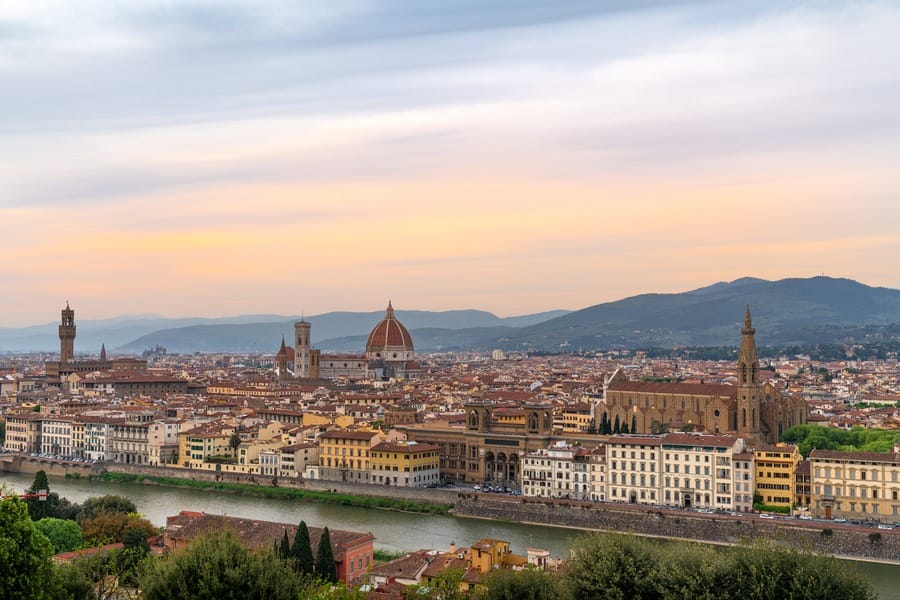
8pm – Dinner
After sunset, we walked back through Piazza del Duomo to see the magnificent dome at night.
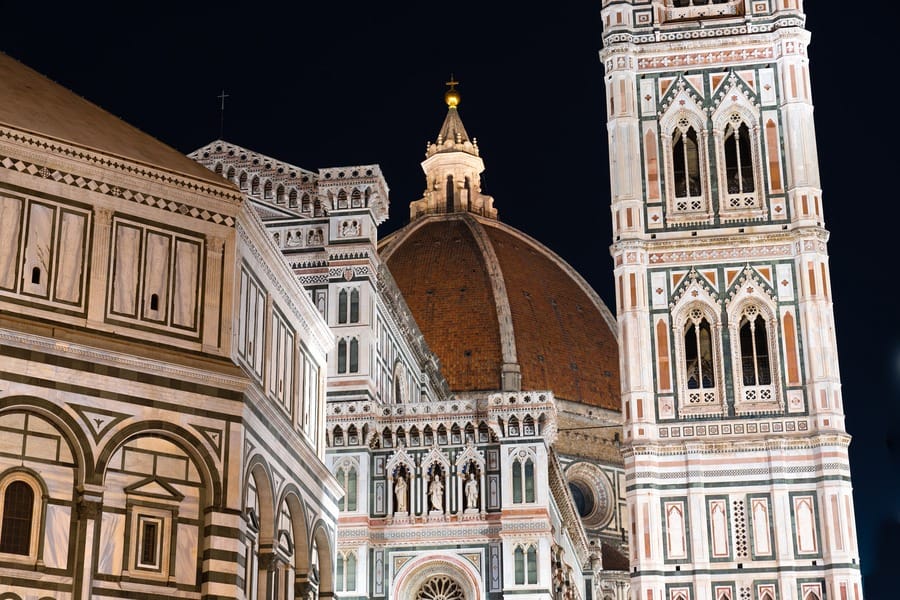
We then grabbed a bite to eat at Ristorante Il Caminetto, a mid-sized restaurant with alfresco seating, located down a quiet side street, a stone’s throw away from the Duomo.
Day 4
9am – Ufizzi Gallery
The Ufizzi Gallery, together with the Galleria dell'Accademia, is one of the most famous art galleries in Italy, meaning it attracts some of the longest queues too. To minimise your waiting time, I suggest visiting the Ufizzi early in the morning and booking fast-track tickets online in advance.
By now, I thought we must have seen the best Renaissance art in Florence, so I wasn’t expecting the Ufizzi to mesmerise me. But mesmerise me, it did. The gallery is filled with hundreds of Greek and Roman sculptures in the main halls and a labyrinth of rooms filled with masterpieces by the likes of Leonardo da Vinci, Michelangelo, Botticelli, Caravaggio, and Rembrandt. I recognised several pieces, like Botticelli’s Birth of Venus, from, well, not living under a rock.
You’ll need a good 3 or 4 hours to thoroughly explore the Ufizzi Gallery, but don’t fret, there’s a café on the second floor for a half-way espresso pitstop.
Book fast-track Ufizzi Gallery tickets online with Viator
Entry: €20 per adult, free for children (under 18)
Hours: 8:15am – 6:50pm, Tuesday - Sunday
12:30pm Visit the Medici Chapels
The Medici Chapels form part of the larger church of San Lorenzo and, like several other churches we’ve seen in Florence, house a series of tombs. This time the tombs belong to several Medici Grand Dukes. The elegant sarcophagi housed inside were designed and sculpted by Michelangelo and/or his students.
The chapels were commissioned by the Medici to be their family’s mausoleum. Perhaps to make sure their dead loved ones rested in the elegance they were accustomed to, the Medici commissioned both Michelangelo and Fillipo Brunelleschi to construct the grandiose buildings.
Book Medici Chapels tickets online with Viator
Entry: €8 per adult
Hours: 8:15am - 2pm, daily
1:30pm – Lunch Break
I suggest grabbing lunch at Osteria Cipolla Rossa, a small restaurant opposite the Medici Chapels.
2:30pm – Visit the Bargello Museum
Before arriving in Florence, we spent 2 days in Rome where we visited Villa Medici, one of the Medici family’s first residences in Rome and where they kept several of their favourite sculptures. While walking through the villa gardens, our guide mentioned the statues we saw were only copies as the originals are in Florence.
Well, in Florence, we got to see those original statues in the Bargello Museum, some of which we recognised from the Netflix series Medici: Masters of Florence (seriously, do you get a hint?). This was the first national museum in Italy, founded in 1865. We spent about an hour walking through the 2-storey museum, admiring exquisite Renaissance paintings and frescos, collections of personal belongings, and many, many bronze and marble sculptures, some by Renaissance artists and some from ancient Roman times.

Book skip-the-line Bargello Museum tickets online with Viator
Entry: €8 or €9 per adult (depending on season), €2 for 18-25 years, €6 per audio guide
Hour 8:15am - 5pm, Monday – Saturday (check current hours & free admission days)
5pm – Visit the Boboli Gardens
After spending most of the day indoors, cross the Ponte Vecchio and soak up the sunshine while strolling around the Boboli Gardens. Considered to be the largest and one of the most beautiful parks in Florence, the Boboli Gardens house an amphitheatre, several fountains, marble sculptures, and centuries-old oak trees.
Book skip-the-line Boboli Gardens tickets online with Viator
Entry: €10 per adult (March-Oct), €6 per adult (Nov-Feb), free for children (under 18)
Hours: 8:15am - 6:50pm (Jun-Aug) closes 6:30pm (Apr, May, Sept, Oct), daily
5:30pm – Visit Palazzo Pitti
Just outside the Bobilli Gardens is Palazzo Pitti, one of the largest architectural wonders in Florence, designed by Filippo Brunelleschi. The property was bought by the Medici’s in 1549 and became the family’s primary residence.
The Pitti Palace now houses a series of museums and galleries, including the Palatine Gallery, which features Renaissance paintings by artists including Raphael; the Treasury of the Grand Dukes, featuring precious stone homewares and jewellery; and the Gallery of Modern Art, featuring Tuscan paintings from the 19th and 20th centuries.
Entry: €16 per adult (March-Oct), €10 per adult (Nov-Feb), free for children (under 18)
Hours: 8:15am - 6:50pm, daily
6:30pm – Dinner
Make the most of being on the south side of the city and grab a bite to eat by the Arno River. I recommend Signorovino which will require a prior booking (use Google Maps).
The Bottom Line
No matter how much Renaissance art I wistfully admired in Florence, I simply couldn’t get enough. While the city’s influential figures of the 15th and 16th centuries shaped art’s evolution, art has given back to the city a sense of deep richness and romantic magnetism that is found nowhere else.
Florence really is pure human emotion.
While around one third of the world’s artistic treasures reside in the Tuscan capital, it would be a mistake to think Florence is just about sculptures, paintings and poetry.
It’s a passionate mingling of food and wine, leather and fashion, academia and religion. Throw in a generous dose of progressive thinking, cobblestone streets and broad piazzas against a backdrop of rolling hills, and you’ve got my favourite city in Italy.
Of course, 4 days in Florence will never feel like enough.
But then again it might be just long enough to fall in love.



































































Reader Comments...
"I respond to every comment by direct private email. I look forward to your feedback" - Josh BenderHello! This is my first visit to your blog! This is my first comment here, so I just wanted to give a quick shout out and say I genuinely enjoy reading your articles. Your blog provided us useful information. You have done an outstanding job!
Thanks a lot for sharing this blog. Really nice and fresh content. All the information is helpful for us.
thanks for writing this article
awesome post.
amazing post once
Write Your Comment
Please DO NOT include links, URLs or HTML in your comments - they will be automated deleted and you will waste your time.